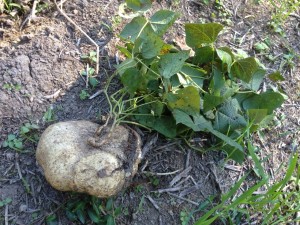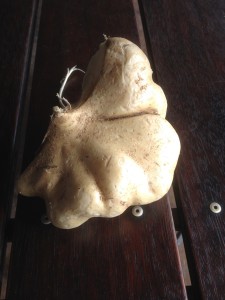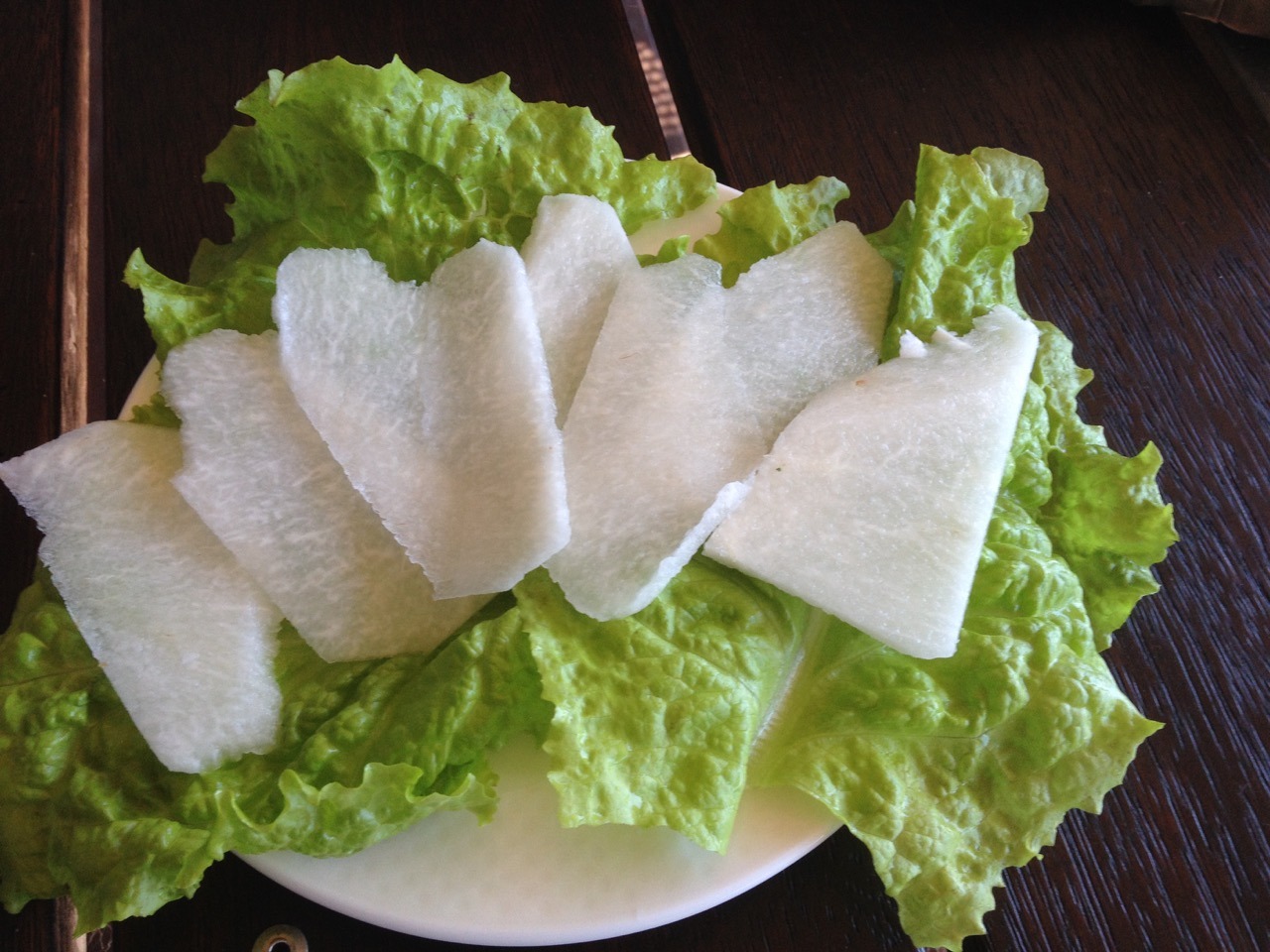Jicama first came to my attention through Jeremy Coleby Williams‘ excellent blog on subtropical gardening, and segment on Gardening Australia. I had also been intrigued by Matthew Kenney‘s raw food recipes, where he uses thinly sliced jicama as a layer in nori rolls. Jicama is another food that is not widely used or available in Australia, so I was keen to try it myself.
In early Winter my jicama plants were looking a bit end-of-season, with some purplish leaves, so I had a go at digging one. I had thought I could feel a golf ball sized tuber with a scratch around at soil surface, so I was amazed to dig up a huge tuber, weighing about a kilo. I was even more amazed when I got it into the kitchen and had a taste; it was delicious! I couldn’t wait to try some of the recipes I’ve seen.
Growing jicama
If you’re also unfamiliar with it, Jicama (pronounced with a Spanish ‘h’) is a tuber which grows under a bean-like vine. It is also called yam bean or Mexican yam. Above ground parts are poisonous but the tuber is mostly eaten raw (I know, there’s a bit of a leap of faith involved there).

It needs a long growing season, so is recommended for subtropical or warmer climates. Like many of the last year’s projects, I only got a bed together for sowing very late, in late December, and even then it was a pretty rudimentary hoe-wide row under the fence in the Mid-levels. The plants were pretty stunted, so my expectations weren’t high and I wasn’t surprised to feel a tuber that was more like a water chestnut than a sweet potato in my first feel-round.
The vines can apparently grow 4 metres high, but mine barely found the fence wire. I was intending to leave them till next season to sprout again, but I’m glad curiosity got the better of me. How such a poorly plant could produce a huge tuber amazes me. Unfortunately this one, my first dig, had split at the top and was mostly discoloured inside, but about a third was white and unspoilt.
I’ve shown through hasty planting that it can grow with some neglect in shallow acid soils, but next year I will dig a proper manured and limed trench, and get the seeds in at the start of the warm weather. Although it likes a climbing support, mine grew happily as a ground cover and ignored the fence, so it could be useful as a weed suppressor. You can dig the tubers anytime at the end of Summer, it seems, and the plants don’t need to die off first.
As the beans are poisonous, it’s good housekeeping to remove the flowers, as this helps the tubers fill too. If you allow a few pods to ripen for next year’s seeds, label them clearly and store them out of harm’s way.
Eating jicama
I read that for storage the tubers shouldn’t be refrigerated, and they certainly keep well, even cut, on the bench. The tubers peel very easily, just with the fingers, although you usually have to cut them along the deep indentations that run down the tubers to get all the dirt off. With the skin off the rest is all edible tuber.
The taste is surprisingly sweet, with the texture of a Nashi Pear. Looking at it, I was expecting something like a raw root vegetable, but it’s the unusual mix of texture and flavour that makes it stand out. It’s not at all starchy, as watery as watermelon but crunchier, not as sweet as fruit but with no acidity to counteract the sweetness. Apparently the sweetness comes from inulin, which is between sugar and fibre in chemical structure, so it doesn’t ramp up blood glucose and has some fibre and pro-biotic benefits. Nutritionally it’s a bit of a desert, though.
In Southeast Asia it is used in fruit salads and rojak, but I was keen to get out my mandolin and use it in nori rolls as Matthew Kenney suggests, hoping the next tuber I dug wouldn’t be split, so I can get good sized sheets.

The next ones I picked were better quality. We had some friends round, so it was an opportunity to try the nori rolls. The mandolin turns out a pile of thin sheets easily, and they don’t have to be as big as I thought to line a sheet of nori. In fact, because of the deep lobes, you really have to trim the tuber down to wedges, so it’s not like you’re going to get nice 20 cm squares.
Our friend Amy has had plenty of experience with jicama, having grown up with it in Malaysia. She usually cooks it, which changes the flavour entirely, including removing the sweetness. I tried stir frying julienned batons with green onion and Chinese duck, which worked very well.
So if you’re looking for a new subtropical (or tropical) crop, I’d heartily recommend jicama. Just put plenty of seeds in, because you’re likely to use all the tubers, or give them away.

